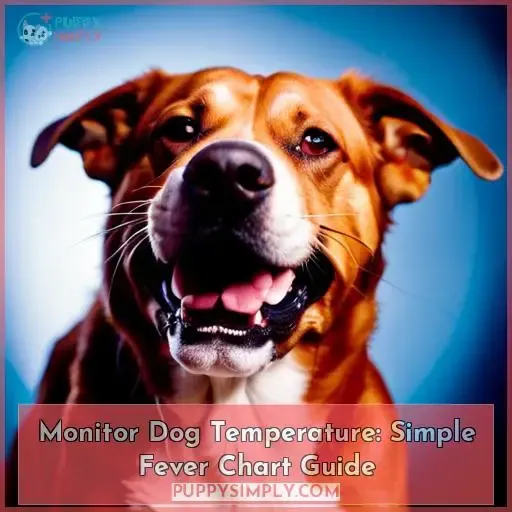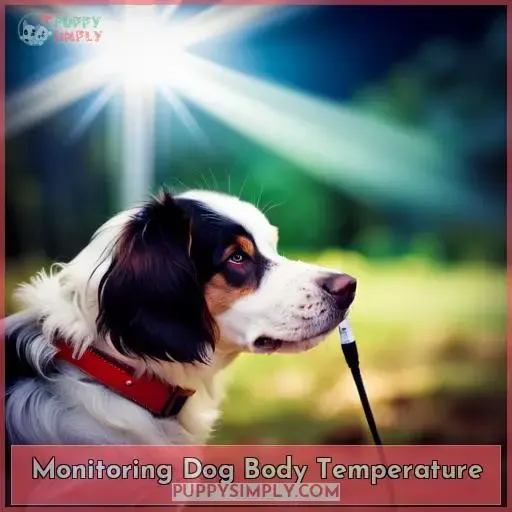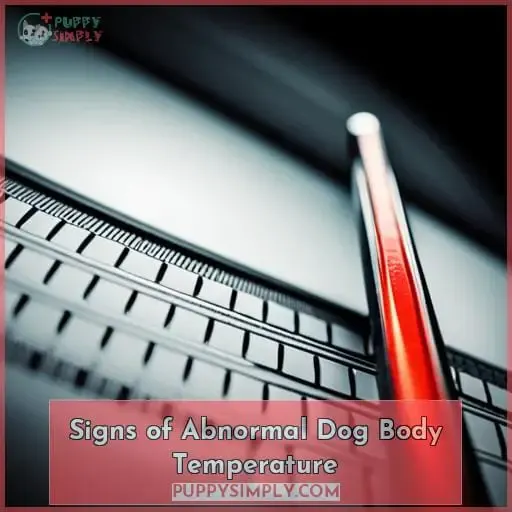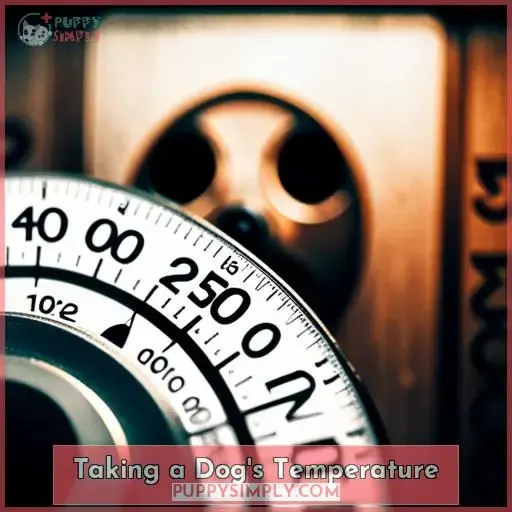This site is supported by our readers. We may earn a commission, at no cost to you, if you purchase through links.
 It’s a common misconception that dog body temperature is the same as human body temperature. While our bodies are both warm-blooded, dogs have an average normal internal core of 100°F to 102.5°F compared to the 98.6°F in humans. This makes it important for pet owners to understand what’s healthy and when there might be cause for concern with their pup’s health status.
It’s a common misconception that dog body temperature is the same as human body temperature. While our bodies are both warm-blooded, dogs have an average normal internal core of 100°F to 102.5°F compared to the 98.6°F in humans. This makes it important for pet owners to understand what’s healthy and when there might be cause for concern with their pup’s health status.
Monitoring a dog’s body temperature can help identify potential problems and enable timely treatment if your pooch has a fever or other issue which could put them at risk of long-term damage.
Table Of Contents
Key Takeaways
- Dog body temperature should be regularly monitored for health issues.
- Puppies under 8 weeks old, with little fur, are vulnerable to heatstroke and hypothermia.
- Different factors such as vaccinations, breed, bedding types, and environmental factors can affect a dog’s body temperature.
- Abnormal body temperature, either too high or too low, requires immediate attention and veterinary consultation.
Understanding Dog Body Temperature
You can use a dog temperature chart to evaluate whether your pup is too cold or running a fever, and take necessary measures if their temperature falls outside the optimal range.
A healthy adult dog’s body temperature should be between 101-102.5°F (38.3°C-39.2°C). If your puppy’s body temp drops below 99°F (37.2°C), it’s time to start taking warming measures. Conversely, if their temp rises above 103°F (39.3°C), cooling methods may be in order.
Vaccinations and breed-specific features play an important role when considering what constitutes normal for each individual canine.
It’s most efficient to keep tabs on your pup using digital thermometers specifically designed with week-old puppies in mind since they tend to have irregular temperatures compared to more mature dogs. This is primarily due to the lack of insulation provided by a thick coat of fur at this stage in their development cycle.
However, consulting a vet experienced with pups is always wise regardless. Just make sure you stay up to date regarding vaccinations, etc.
In any case where the primary caregiver has doubts about how serious things might really be vis à vis this subject matter, then professional guidance from a veterinarian should always take precedence over anything else recommended here today.
What is the Optimal Temperature for Dogs?
An optimal temperature range for your beloved pup is between 101-102.5°F (38.3°C-39.
Vaccinations and breed can play an important role in determining what’s normal, as well as bedding types, environmental factors like tree coverage, and matted coats – especially for puppies under 8 weeks old with little fur yet!
Digital thermometers designed specifically with pups’ irregular temperatures in mind are best for monitoring temp changes at home but consulting a vet experienced in puppy care should always take precedence if unsure or the pup shows signs of illness.
If the body temp drops below 99ºF (37.2ºC) then warming measures must be taken; conversely cooling methods may be necessary if it rises above 103ºF (39.
Whelping calculators provide estimates based on ovulation time but paw wax can indicate labor within 24-48 hours after experiencing a temperature drop which could also signal low calcium levels that need boosting through tablets carefully administered during pregnancy – too much supplementation late into gestation risks eclampsia/milk fever though so consult experts before taking any action yourself just to stay safe all around!
Monitoring Dog Body Temperature
It’s essential to regularly track your pup’s body temperature, so you can be sure they’re as healthy and happy as possible! Use a digital thermometer designed for puppies with irregular temperatures – this way you’ll notice even the smallest variations.
When it drops below 99°F (37.2°C) or rises above 103°F (39.3º), take preventive measures like warming up or cooling down accordingly.
With Petcube camera monitoring technology, heat exhaustion due to big changes in body temperature can also be monitored remotely from anywhere at any time.
By keeping an eye on all these indicators of change in your pet’s health, you’ll have peace of mind that their wellbeing is always properly taken care of.
Signs of Abnormal Dog Body Temperature
It is important to know the signs of abnormal body temperature in your pup, so you can take action if necessary. If their temperature drops below 99°F (37.2°C), it could mean they are too cold, while a fever above 103°F (39.
3°C) indicates that cooling measures should be taken at home or professional medical care should be sought after immediately if over 106 degrees Fahrenheit. Using a dog temperature chart will help evaluate whether your pet’s body temperature falls within an optimal range or not and allow you to make informed decisions about how best to act accordingly.
Too Cold
If you notice your pup shivering, it may be time to take action and warm them up. Preventing hypothermia is important in canine first aid, especially during temperature regulation in cold weather. If the late evening brings a cool breeze or if they have white fur, drastic changes in temperature can affect young puppies more than adults.
Check for heat exhaustion as well – panting excessively or lethargy are indicators that something’s wrong. Make sure their coat is dry and bundle them up with extra blankets or clothing on particularly chilly days.
Fever
You should seek veterinary attention immediately if your pup is running a fever above 103°F (39.
Risk factors for puppy fever include early mornings, high-quality fabrics, and room temperatures that are too high.
To manage canine heat, you can keep their body temperature at an optimal level by providing cooling measures such as fans or ice packs. This will help reduce the risk of severe complications from a high dog temperature.
Additionally, keeping watch on their behavior and monitoring any drops in their normal body temperatures will help you determine when they may need further assistance from the vet or pet emergency fund.
Don’t hesitate to take action when needed – safety first!
Taking a Dog’s Temperature
Taking your pup’s temperature is an important step when tracking their health and wellbeing. It can help you determine if they’re running a fever or feeling too cold, alerting you to any potential issues so that appropriate measures can be taken.
Utilizing a dog temperature chart will ensure the optimal range of 101-102.5°F (38.3°C-39.2°C) is maintained for your pet’s safety and comfort. It will also provide an extra layer of protection against illness or disease in dogs with lower immunity due to age or other medical conditions such as diabetes mellitus or Cushing’s Disease.
To take an accurate measure of body temperature, use a rectal thermometer for pups younger than 8 weeks old and an ear thermometer for older puppies. Both should be used according to the instructions provided by the manufacturer, and remember to clean them properly before each use.
In order to stay on top of Fido’s general health, it would also be beneficial to keep track of hydration levels, vaccination records, exercise intensity, and body weight.
How to Safely Adjust Dog Body Temperature
Maintaining a healthy body temperature is important to keep your pup safe and comfortable. To help you monitor their wellness, it’s essential to understand how to safely adjust their body temperature using warming and cooling measures with the help of a dog temperature chart.
Warming Measures
If your pup’s temperature is below the optimal range, it’s important to take warming measures. A good way to do this is by using heat pads and cooling mats. Heat pads can be placed in bedding or under blankets for extra body warmth.
Cooling mats are ideal when a cooler surface needs to be provided – like on hot summer days or around room humidity levels that may make Fido uncomfortable.
Temperature drops also require necessary precautions. Calcium tablets can help boost calcium levels if needed, but care must be taken with supplementation during pregnancy as eclampsia or milk fever may occur if given too close to whelping time.
Cooling Measures
When a dog’s temperature is above 103°F (39.3°C), it’s important to take cooling measures to bring the temperature down and help your pup feel better.
Keeping an eye on environmental temperatures and providing cooler air moves like fans, open windows, or doors can be helpful in reducing fever prevention.
A water-based lubricant spray may also provide some relief, as well as finding a shady tree for Fido if near morning walks are taken daily.
Temperature tracking should also go hand-in-hand with cooling techniques when caring for whelping puppies; calcium supplementation may need adjustment during this time too, so consulting a vet is key in managing nearly mornings accordingly!
When to Consult a Vet
Consulting a vet if your pup’s temperature falls outside the optimal range is key to ensuring their well-being. It’s important to understand when it’s time for a vet visit and what treatments are available for puppy care, fever treatments, heat stroke, and other illnesses.
There are specific veterinary guidelines on how to regulate body temperature in newborn puppies as well as adult dogs based on breed size. If you’re unsure about the severity of your pet’s condition or if there is a danger of infectious diseases, always consult with local vets or an emergency room veterinarian before attempting treatment at home.
Heatstroke can be life-threatening, so make sure you know the signs: excessive panting, drooling from the mouth/nose, erratic behavior/vomiting/diarrhea, and staggering gait.
- Monitor behavior closely.
- Take accurate readings with a dog temperature chart.
- Be aware of symptoms and teach kids safety around pets.
- Seek help sooner rather than later – early detection saves lives!
- Consider talking with experienced owners regarding best practices in caring for puppies and sickly dogs – knowledge sharing helps us all prepare better against unexpected medical expenses!
Frequently Asked Questions (FAQs)
What should I do if my dog’s temperature is outside the normal range?
If your dog’s temperature is outside the normal range, you should monitor their behavior and consult a vet. Warming measures can be taken if too cold, or cooling methods used to reduce fever. If unsure, seek professional advice as quickly as possible – temperatures over 106°F can be life-threatening.
A Dog Whelping Temperature Chart may also help predict whelping date and labor signs.
What are the risks of supplementing calcium during pregnancy?
Supplementing calcium during pregnancy can cause eclampsia or milk fever, which is potentially dangerous. Take care when supplementing calcium and consult your vet if you’re unsure. Seek advice before the last six weeks of pregnancy to ensure safety for both you and your dog.
How can I determine when my dog will give birth?
To determine when your dog will give birth, look for a drop in their temperature. This typically occurs 24-48 hours before labor begins. You can also use a Dog Whelping Temperature Chart to predict the whelping date, although it’s only an educated guess without knowing the ovulation time.
Monitor behavior and consult your vet if you are unsure or concerned about any issues.
Can I take my dog’s temperature at home?
Yes, you can take your dog’s temperature at home. Use a rectal thermometer and follow the instructions carefully to obtain an accurate reading. Ensure to monitor your pup for any signs of illness as well; if there are none, then it’s likely nothing serious.
What signs indicate that my dog may have a fever?
If your dog is lethargic, panting heavily, has red gums, or a warm nose tip, it may indicate they have a fever. Take their temperature using an accurate thermometer to confirm and seek vet attention if the reading is over 103°F (
Conclusion
Monitoring your dog’s temperature is an important part of keeping them healthy and happy. Having a dog temperature chart is a great way to help you stay on top of their health. Knowing what is considered a normal temperature range for your pup and what to do if their temperature falls outside of that range can help you keep them safe and healthy.
If your pup’s temperature falls outside of the normal dog temperature chart range, it’s important to take action. If they’re too cold, warming measures can be taken at home. If they have a fever, cooling measures can be taken.
If you’re unsure, it’s best to consult a vet and monitor your pup’s behavior. In any case, if your pup shows signs of illness, it’s important to seek veterinary attention.
With the right knowledge and tools, you can effectively monitor your pup’s temperature and ensure they stay healthy and safe.













